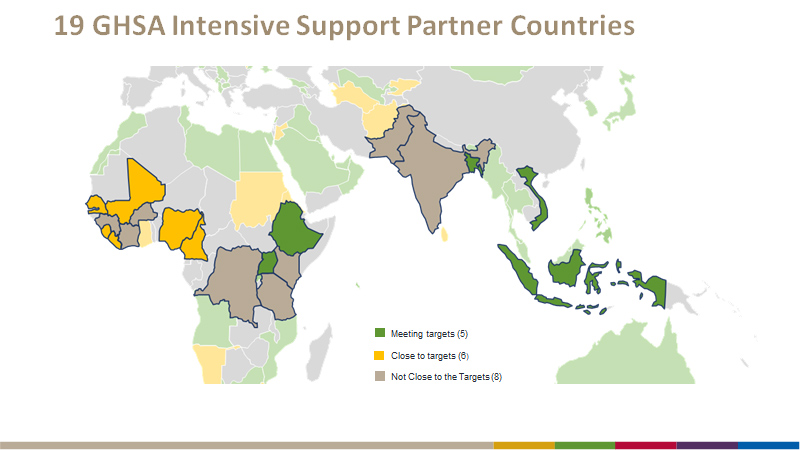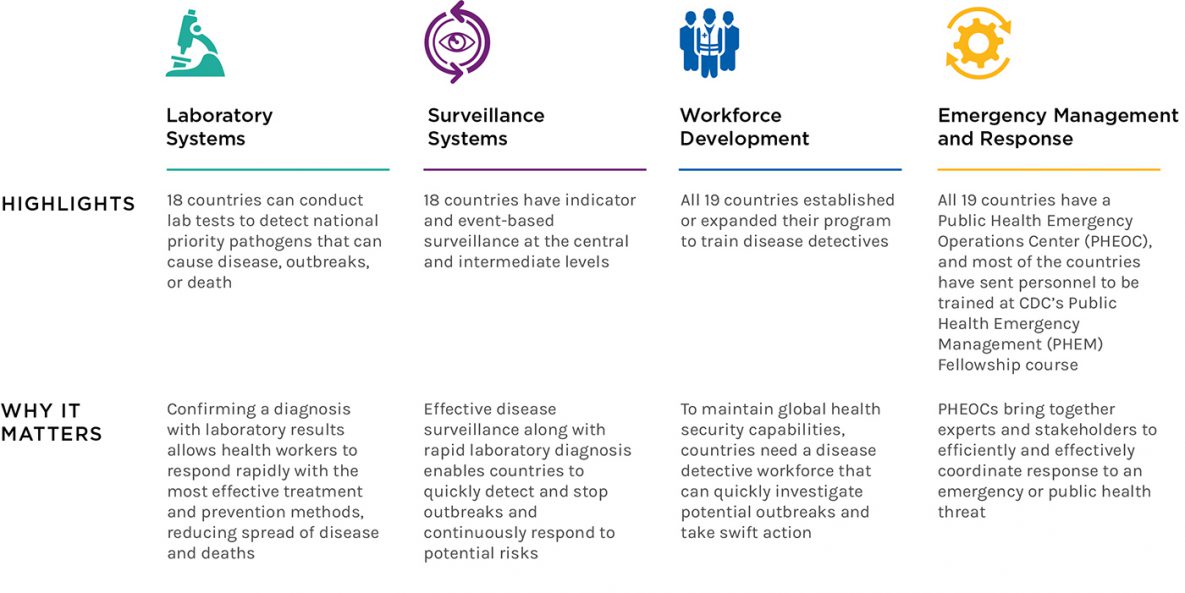CDC Driven Progress as of 2019
Over the course of five years of GHSA, all 19 CDC-supported countries have improved their capacity to prevent, detect, and respond to infectious disease threats.
All 19 GHSA countries have increased capacities in at least one indicator in each technical area compared with baseline estimates. Five countries have met the target by reaching “Demonstrated Capacity” in five technical areas. Six countries are close to meeting the target – three or four technical areas have reached demonstrated capacity.

Key Achievements of GHSA from 2014 – Present

Stories of Foundational Improvements in Global Health Security

Before the West Africa Ebola Virus Disease (EVD) epidemic, Liberia had no system in place for getting clinical samples from remote areas to diagnostic labs – a journey that could take as many as eight hours on public transportation or over difficult terrain. Through Riders for Health, motorcycle couriers offered Liberia an innovative solution for safely getting samples from local clinics to diagnostic labs. With support from the CDC Foundation, U.S. Agency for International Development (USAID), the World Health Organization, and CDC, riders were trained in infection prevention and control, and in motorcycle safety and maintenance. Before Riders for Health, only 25% of samples in Liberia reached a laboratory within 24 hours. Today, that number has increased to about 80%.
Laboratory
“Strong laboratory networks are one of the keys to global health security. Continued investment in laboratory systems that can detect priority pathogens allows for life-saving, rapid response.”
— Scott J. Becker, Chief Executive Officer, Association of Public Health Laboratories
In 2015, Pakistan was experiencing an outbreak from an unknown pathogen. CDC identified Candida auris, a life-threatening, multidrug-resistant fungus, as the cause and quickly alerted Pakistan health authorities about the threat. CDC worked with the Pakistan National Institute of Health (NIH) to implement a pilot program of laboratory-based surveillance for C. auris, providing on-site training to pilot hospitals and the NIH on identifying infections and determining whether they are resistant to treatment. With CDC support, pilot hospitals have begun reporting suspected cases and sending samples to Pakistan NIH for testing. Pakistan’s NIH Microbiology and Field Epidemiology & Disease Surveillance Division monitored reported cases to stop outbreaks faster. Pakistan plans to increase the number of surveillance sites once the pilot program is complete. More robust identification and surveillance will help contain the spread of C. auris, particularly the most drug-resistant strains, many of which have been found in Pakistan.
Surveillance
“Partnerships and investment in surveillance networks are critical to preventing, detecting and responding to the next disease threat.”
– John Auerbach, President and CEO, Trust for America’s Health

From March to April 2019, surveillance staff at the Tay Nguyen Institute of Hygiene and Epidemiology (TIHE) in Vietnam’s Central Highlands noted increased dengue cases in Gia Lai province. A recently trained FETP fellow and member of the TIHE surveillance team joined the Gia Lai provincial rapid response team to investigate the dengue outbreak. By applying what she learned in the FETP training, the recent FETP fellow was able to collect essential data and conduct data analysis related to the dengue outbreak. Through Vietnam’s newly established network of EOCs – developed in part with the support of CDC– the surveillance team could compile, analyze, and interpret the data while working within TIHE’s EOC. Workforce development, as exemplified by FETP training, along with Vietnam’s newly established public health infrastructure and data sharing, continue to help inform public health decision makers and guide the country’s response to disease outbreaks.
Workforce
“Sustained investment in frontline health workforce teams is foundational to global health security. Highly-trained and well-supported epidemiologists, nurses, midwives, community health workers, physicians, pharmacists, veterinarians and other frontline disease detectives must coordinate and collaborate to rapidly prevent, detect and respond to emerging and re-emerging health threats.”
– Vince Blaser, Director, Frontline Health Workers Coalition Secretariat, IntraHealth International
In a part of the world already fighting to contain EVD, CCHF may be initially misidentified as EVD, highlighting the need for effective surveillance and laboratory testing to correctly diagnose and contain the infectious pathogen before it spreads. In Uganda, when an alert of suspected CCHF cases in two regions was received, CDC-trained scientists at the Uganda Virus Research Institute (UVRI) National Reference Laboratory confirmed CCHF through molecular diagnostics within 24 hours. In each instance, health facilities were able to use national surveillance and reporting systems to immediately report the cases to Uganda’s PHEOC, which in turn quickly mobilized national rapid responders to collect samples and provide technical assistance to healthcare workers. As a result of U.S. Government investments in the Ministry of Health’s infection prevention and control activities and viral hemorrhagic fever diagnostics, Uganda has developed the ability to rapidly act to contain deadly outbreaks, including that of CCHF and EVD.
Emergency Operations/Preparedness
“Functional, exercised emergency operations capacity is a critical component of global health security. CDC’s critical support to countries around the world has enabled improved preparedness for biological events, whether naturally occurring, deliberate or accidental, which threaten public health and international security.”
– Beth Cameron, Vice President, Nuclear Threat Initiative
